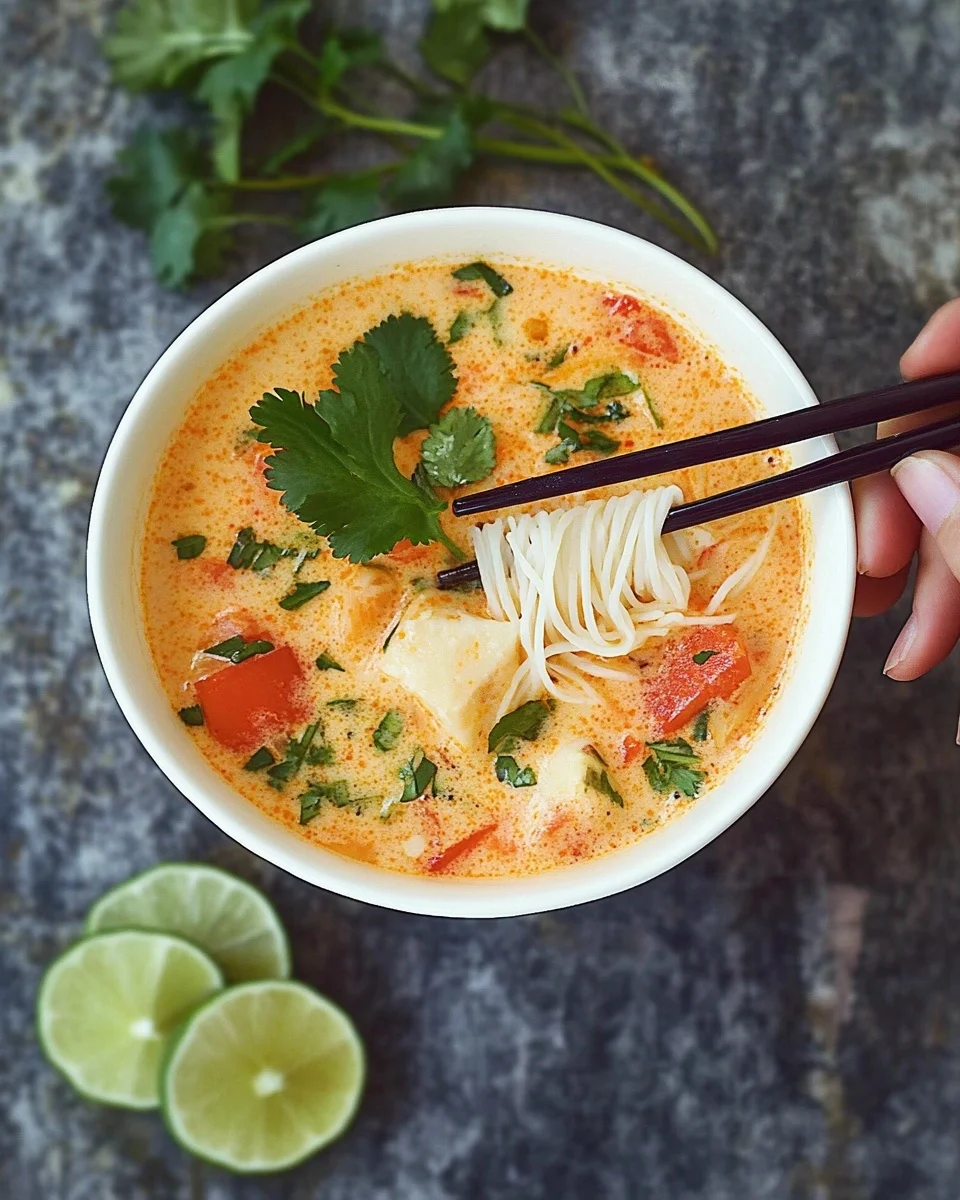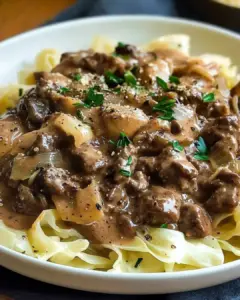Introduction: A Perfect Blend of Spice, Creaminess, and Aromatic Goodness
Few dishes capture the essence of Thai cuisine as beautifully as Thai Red Curry Noodle Soup. This rich and fragrant soup combines the heat of red curry paste, the silkiness of coconut milk, the savoriness of broth, and the freshness of herbs, creating an indulgent yet light meal.
This soup is a fusion of Thai curry and traditional noodle soups, making it both comforting and exciting. It’s perfect for chilly nights, weeknight dinners, or when you crave something deeply flavorful yet easy to prepare. Whether you enjoy it with chicken, shrimp, tofu, or vegetables, this dish is incredibly versatile and customizable.
In this guide, we’ll explore the origins, health benefits, serving suggestions, expert cooking tips, variations, and frequently asked questions about this delightful dish.
The Origins of Thai Red Curry Noodle Soup
Thai cuisine is renowned for its bold flavors, vibrant colors, and fragrant spices. Thai red curry, which forms the heart of this soup, originates from central Thailand and is a staple in both home kitchens and street food stalls.
The combination of red curry paste with creamy coconut milk and aromatic herbs is what makes Thai red curry a beloved dish. When combined with noodles, it transforms into a fusion dish that blends traditional Thai flavors with the comfort of a noodle soup.
This dish has gained international popularity, with variations appearing in Asian fusion restaurants and home kitchens worldwide. It’s a perfect balance of heat, creaminess, and umami, making it an instant favorite.
Why You’ll Love Thai Red Curry Noodle Soup
Thai Red Curry Noodle Soup isn’t just delicious—it’s a nutrient-rich and wholesome meal that comes together in under 30 minutes. Here’s why you should add it to your meal rotation:
1. Bursting with Bold, Aromatic Flavors
The spicy and fragrant red curry paste, combined with creamy coconut milk and fresh herbs, creates a layered and complex taste experience.
2. Quick and Easy to Make
With simple ingredients and minimal prep, this dish comes together quickly, making it perfect for busy weeknights.
3. Customizable for Any Diet
Whether you’re vegetarian, vegan, gluten-free, or a meat lover, this dish can be easily adapted to fit your dietary preferences.
4. Packed with Nutrients
This soup is rich in protein, fiber, and healthy fats from coconut milk, lean proteins, and fresh vegetables.
5. A Perfect One-Bowl Meal
With protein, vegetables, and noodles all in one dish, this soup is a complete, satisfying meal with no extra sides required.
Ingredients
- Protein and Seasoning:
- Boneless, skinless chicken breasts, diced
- Olive oil
- Kosher salt
- Freshly ground black pepper
- Aromatics and Vegetables:
- Garlic cloves, minced
- Red bell pepper, diced
- Onion, diced
- Fresh ginger, grated
- Flavor Base:
- Red curry paste
- Low-sodium chicken broth
- Coconut milk
- Noodles and Seasonings:
- Rice noodles
- Fish sauce
- Brown sugar
- Herbs and Garnishes:
- Green onions, thinly sliced
- Fresh cilantro leaves, chopped
- Fresh basil leaves, chopped
- Fresh lime juice
Directions
- Sear the Chicken:
- In a large stockpot or Dutch oven, heat olive oil over medium heat. Season the diced chicken with salt and pepper. Add the chicken to the pot and cook until golden brown, approximately 2-3 minutes. Remove and set aside.
- Sauté Aromatics:
- In the same pot, add minced garlic, diced red bell pepper, and diced onion. Cook, stirring occasionally, until the vegetables are tender, about 3-4 minutes.
- Incorporate Curry Paste and Ginger:
- Stir in red curry paste and freshly grated ginger. Cook until fragrant, roughly 1 minute.
- Prepare the Broth:
- Pour in the low-sodium chicken broth and coconut milk, ensuring to scrape any browned bits from the bottom of the pot.
- Simmer with Chicken:
- Return the seared chicken to the pot. Bring the mixture to a boil, then reduce heat and let it simmer, stirring occasionally, until the soup reduces slightly, about 10 minutes.
- Add Noodles and Seasonings:
- Introduce the rice noodles, fish sauce, and brown sugar to the pot. Continue to cook until the noodles are tender, approximately 5 minutes.
- Finalize with Herbs and Lime:
- Remove the pot from heat. Stir in sliced green onions, chopped cilantro, chopped basil, and freshly squeezed lime juice. Adjust seasoning with additional salt and pepper if needed.
- Serve Immediately:
- Ladle the soup into bowls and enjoy promptly.
Nutritional Information (Per Serving)
- Calories: Approximately 350
- Protein: 25g
- Carbohydrates: 30g
- Fat: 15g
- Saturated Fat: 10g
- Cholesterol: 60mg
- Sodium: 900mg
- Fiber: 3g
- Sugar: 6g
Note: Nutritional values are approximate and can vary based on specific ingredients used.
Best Ways to Serve Thai Red Curry Noodle Soup
While this soup is incredibly delicious on its own, pairing it with the right sides and toppings enhances the experience. Here are some serving suggestions:
1. Fresh Herb Garnish
Top your bowl with chopped cilantro, basil, and green onions for a fresh, aromatic touch.
2. A Squeeze of Lime
Fresh lime juice brightens the flavors and enhances the soup’s natural tanginess.
3. Crispy Toppings
Add some crispy shallots, fried garlic, or crushed peanuts for extra texture and crunch.
4. Pair with a Light Side Dish
Serve alongside a Thai papaya salad or fresh spring rolls for a well-rounded meal.
5. Adjust the Spice Level
If you prefer a milder version, reduce the red curry paste. For more heat, add extra Thai chilies or chili oil.
Creative Variations of Thai Red Curry Noodle Soup
One of the best things about this dish is its versatility. You can experiment with different proteins, vegetables, and spice levels to make it your own.
1. Protein Variations
- Classic Chicken – Tender chunks of chicken make for a hearty and comforting version.
- Seafood Delight – Add shrimp, mussels, or squid for a seafood twist.
- Vegetarian & Vegan – Use tofu, mushrooms, and extra veggies for a plant-based version.
2. Broth Adjustments
- Traditional Clear Broth – Keep the soup lighter and brothier by reducing the coconut milk.
- Creamy & Rich – Increase the coconut milk for a thicker, more indulgent soup.
3. Noodle Options
- Rice Noodles – A classic choice that soaks up the curry broth beautifully.
- Egg Noodles – For a chewier texture, try egg noodles.
- Zucchini Noodles – A low-carb alternative that works well with this dish.
4. Spice Adjustments
- Mild & Kid-Friendly – Use less curry paste and omit the chili peppers.
- Extra Spicy – Add Thai bird chilies, chili flakes, or Sriracha for an extra kick.
Expert Tips for Making the Best Thai Red Curry Noodle Soup
To ensure your soup turns out flavorful, creamy, and perfectly balanced, follow these expert tips:
1. Use High-Quality Thai Red Curry Paste
The curry paste is the foundation of the dish. Opt for authentic Thai brands for the best flavor.
2. Don’t Overcook the Noodles
Rice noodles cook quickly! Add them to the soup at the last minute to prevent them from becoming mushy.
3. Balance the Flavors
Thai cooking is all about balancing spicy, sweet, salty, and sour flavors. Adjust the fish sauce, lime juice, and sugar as needed.
4. Use Fresh Ingredients
Fresh ginger, garlic, and herbs elevate the flavors. Avoid using dried substitutes whenever possible.
5. Simmer the Broth for Depth
Let the broth simmer for at least 10 minutes to fully develop the flavors before adding the noodles and toppings.
Frequently Asked Questions (FAQs)
1. Can I make Thai Red Curry Noodle Soup ahead of time?
Yes! You can prepare the broth in advance and store it in the fridge for up to 3 days. However, cook the noodles fresh before serving to avoid sogginess.
2. Can I freeze this soup?
Yes, but it’s best to freeze the broth separately without the noodles. Reheat and add fresh noodles before serving.
3. What if I don’t have fish sauce?
You can substitute soy sauce or tamari for a similar umami flavor.
Advertisement
4. How do I make it less spicy?
Reduce the amount of red curry paste and omit Thai chilies. Adding extra coconut milk can also help mellow the spice.
5. Can I use curry powder instead of curry paste?
Curry powder doesn’t provide the same depth of flavor as Thai red curry paste. If substituting, use extra aromatics like ginger, garlic, and lemongrass to compensate.
6. What’s the best way to reheat leftovers?
Reheat the broth over low heat on the stovetop, adding fresh noodles before serving. Avoid microwaving, as it can overcook the noodles.
Conclusion: A Comforting Bowl of Thai Perfection
Thai Red Curry Noodle Soup is the ultimate comfort dish, offering spicy warmth, creamy richness, and refreshing citrus notes in every bite. Whether you’re craving something quick and easy or looking to impress guests with an authentic Thai-inspired meal, this dish is a must-try.
With its endless variations, customizable spice levels, and rich flavors, this soup belongs in your regular meal rotation. Try it today and bring a taste of Thailand to your kitchen!






